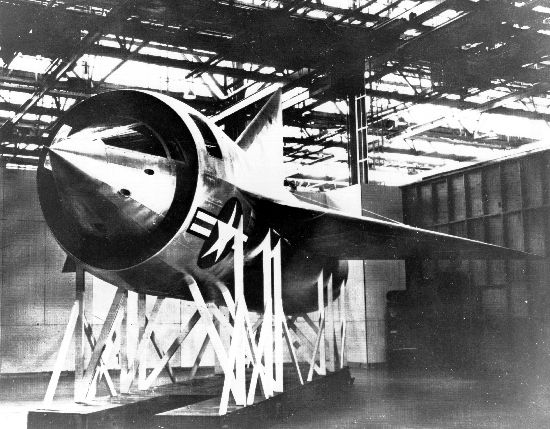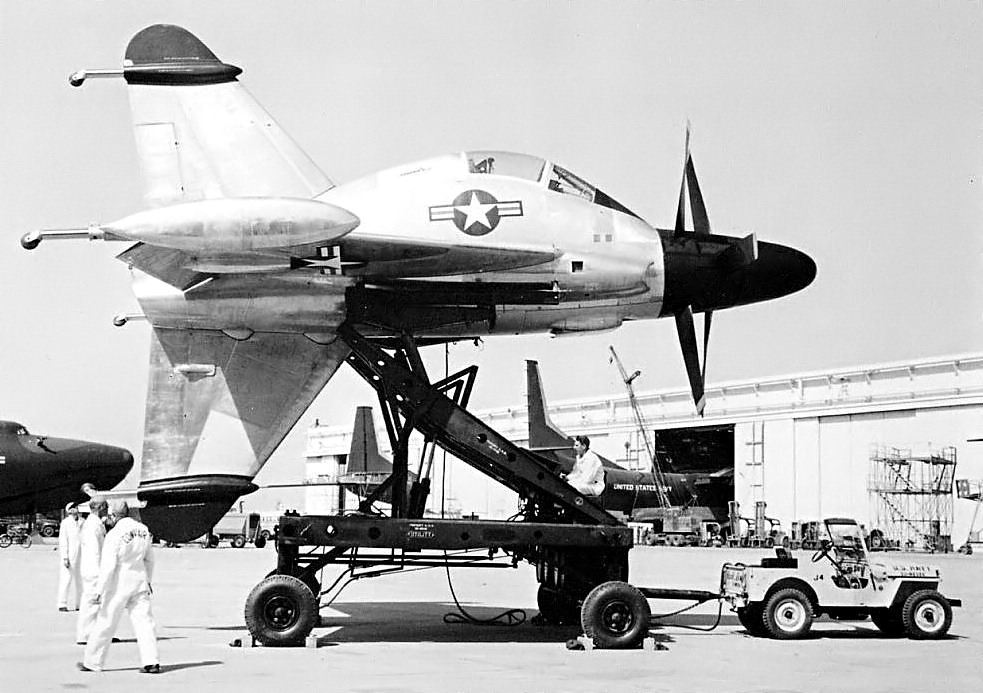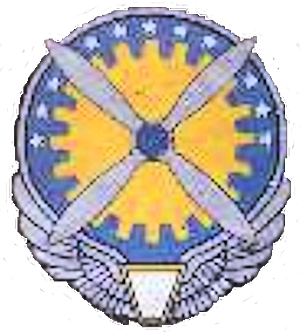|
XF-92A
The Convair XF-92 (re-designated from XP-92 in 1948) was an American, delta wing, first-generation jet prototype. Originally conceived as a point-defence interceptor, the design was later used purely for experimental purposes and only one was built. However, it led Convair to use the delta-wing on a number of designs, including the F-102 Delta Dagger, F-106 Delta Dart, B-58 Hustler, the US Navy's F2Y Sea Dart as well as the VTOL FY Pogo. Design and development Early work Prior to August 1945, the Vultee Division of Consolidated-Vultee looked at the possibility of a swept-wing aircraft powered by a ducted rocket. Years earlier, the company had performed designs which involved liquid-cooled radiator engines. With this design, fuel would be added to the heat produced by small rocket engines in the duct, creating a "pseudo-ramjet".Jenkins and Landis 2008, p. 122. In August 1945, the United States Army Air Forces (USAAF), soon to be renamed the United States Air Force, issu ... [...More Info...] [...Related Items...] OR: [Wikipedia] [Google] [Baidu] |
Lippisch DM-1
The Lippisch DM-1 was a single-seat research glider that was designed and built in Germany from 1944. Development During World War II, Dr. Alexander Lippisch proposed a ramjet propelled point defence fighter, the Lippisch P.12/13a. It was a sharply-swept delta flying wing with the engine buried in a thick, blunt-nosed wing. The pilot was accommodated in the forward section of the tail fin, which was as thick as the wings and almost as large. A scale model of the P.12/13a was successfully flown at Spitzerberg, near Vienna.Dan Sharp; ''Luftwaffe: Secret Jets of the Third Reich'', Mortons, 2015, p.119. Lippisch himself lost interest in the design and began work on the P.13b with a different wing, but he was approached by students of Akaflieg Darmstadt and Akaflieg München, who asked for vital war work so that they would not be drafted. By this time in 1944 Lippisch realised that the war was hopeless and was happy to oblige, arranging for them to build a full-scale aerodyna ... [...More Info...] [...Related Items...] OR: [Wikipedia] [Google] [Baidu] |
Convair
Convair, previously Consolidated Vultee, was an American aircraft manufacturing company that later expanded into rockets and spacecraft. The company was formed in 1943 by the merger of Consolidated Aircraft and Vultee Aircraft. In 1953, it was purchased by General Dynamics, and operated as their Convair Division for most of its corporate history. Convair is best known for its military aircraft; it produced aircraft such as the Convair B-36 Peacemaker and Convair B-58 Hustler strategic bombers, and the Convair F-102 Delta Dagger and Convair F-106 Delta Dart interceptors. It also manufactured the first Atlas rockets, including the rockets that were used for the crewed orbital flights of Project Mercury. The company's subsequent Atlas-Centaur design continued this success and derivatives of the design remain in use as of 2020. The company also entered the jet airliner business with its Convair 880 and Convair 990 designs. These were smaller than contemporary aircraft like ... [...More Info...] [...Related Items...] OR: [Wikipedia] [Google] [Baidu] |
Alexander Lippisch
Alexander Martin Lippisch (November 2, 1894 – February 11, 1976) was a German aeronautical engineer, a pioneer of aerodynamics who made important contributions to the understanding of tailless aircraft, delta wings and the ground effect, and also worked in the U.S. Within the Opel-RAK program, he was the designer of the world's first rocket-powered glider. He developed and conceptualized delta wing designs which functioned practically in supersonic delta wing fighter aircraft as well as in hang gliders. People he worked with continued the development of the delta wing and supersonic flight concepts over the 20th century. His most famous designs are the Messerschmitt Me 163 rocket-powered interceptorReitsch, H., 1955, The Sky My Kingdom, London: Biddles Limited, Guildford and King's Lynn, and the Dornier Aerodyne. Early life Lippisch was born in Munich, Kingdom of Bavaria. He later recalled that his interest in aviation began with a demonstration conducted by Orville Wright ... [...More Info...] [...Related Items...] OR: [Wikipedia] [Google] [Baidu] |
Consolidated Vultee
Convair, previously Consolidated Vultee, was an American aircraft manufacturing company that later expanded into rockets and spacecraft. The company was formed in 1943 by the merger of Consolidated Aircraft and Vultee Aircraft. In 1953, it was purchased by General Dynamics, and operated as their Convair Division for most of its corporate history. Convair is best known for its military aircraft; it produced aircraft such as the Convair B-36 Peacemaker and Convair B-58 Hustler strategic bombers, and the Convair F-102 Delta Dagger and Convair F-106 Delta Dart interceptors. It also manufactured the first Atlas rockets, including the rockets that were used for the crewed orbital flights of Project Mercury. The company's subsequent Atlas-Centaur design continued this success and derivatives of the design remain in use as of 2020. The company also entered the jet airliner business with its Convair 880 and Convair 990 designs. These were smaller than contemporary aircraft like ... [...More Info...] [...Related Items...] OR: [Wikipedia] [Google] [Baidu] |
Convair B-58 Hustler
The Convair B-58 Hustler, designed and produced by American aircraft manufacturer Convair, was the first operational bomber capable of Mach 2 flight. The B-58 was developed during the 1950s for the United States Air Force (USAF) Strategic Air Command (SAC). To achieve the high speeds desired, Convair chose a delta wing design used by contemporary fighters such as the Convair F-102. The bomber was powered by four General Electric J79 engines in underwing pods. It had no bomb bay: it carried a single nuclear weapon plus fuel in a combination bomb/fuel pod underneath the fuselage. Later, four external hardpoints were added, enabling it to carry up to five weapons. The B-58 entered service in March 1960, and flew for a decade with two SAC bomb wings: the 43rd Bombardment Wing and the 305th Bombardment Wing. It was considered difficult to fly, imposing a high workload upon its three-man crews. Designed to replace the subsonic Boeing B-47 Stratojet strategic bomber, the B-58 be ... [...More Info...] [...Related Items...] OR: [Wikipedia] [Google] [Baidu] |
Convair XP-92 Mockup
Convair, previously Consolidated Vultee, was an American aircraft manufacturing company that later expanded into rockets and spacecraft. The company was formed in 1943 by the merger of Consolidated Aircraft and Vultee Aircraft. In 1953, it was purchased by General Dynamics, and operated as their Convair Division for most of its corporate history. Convair is best known for its military aircraft; it produced aircraft such as the Convair B-36 Peacemaker and Convair B-58 Hustler strategic bombers, and the Convair F-102 Delta Dagger and Convair F-106 Delta Dart interceptors. It also manufactured the first Atlas rockets, including the rockets that were used for the crewed orbital flights of Project Mercury. The company's subsequent Atlas-Centaur design continued this success and derivatives of the design remain in use as of 2020. The company also entered the jet airliner business with its Convair 880 and Convair 990 designs. These were smaller than contemporary aircraft like ... [...More Info...] [...Related Items...] OR: [Wikipedia] [Google] [Baidu] |
Convair XFY Pogo
The Convair XFY Pogo was an experiment in vertical takeoff and landing (VTOL) tail-sitter. The Pogo had delta wings and three-bladed contra-rotating propellers powered by a turboprop engine. It was intended to be a high-performance fighter aircraft capable of operating from small warships. Landing the XFY-1 was difficult, as the pilot had to look over his shoulder while carefully working the throttle to land. Design and development After World War II, the Cold War prompted the United States Army and Navy to study VTOL operations. It was envisaged to protect task forces, convoys or any fleet, even without aircraft carriers, by placing VTOL aircraft on any ship. These fighters would be housed within a conical protective housing, saving limited deck space available aboard ships. They would provide first line of airborne defense and reconnaissance capability, before more aircraft could be scrambled to help, with flight performance that helicopters could not provide. In May 1951, Lo ... [...More Info...] [...Related Items...] OR: [Wikipedia] [Google] [Baidu] |
Wright-Patterson Air Force Base
Wright-Patterson Air Force Base (WPAFB) is a United States Air Force base and census-designated place just east of Dayton, Ohio, in Greene County, Ohio, Greene and Montgomery County, Ohio, Montgomery counties. It includes both Wright and Patterson Fields, which were originally Wilbur Wright Field and Fairfield Aviation General Supply Depot. Patterson Field is approximately northeast of Dayton, Ohio, Dayton; Wright Field is approximately northeast of Dayton. The host unit at Wright-Patterson AFB is the 88th Air Base Wing (88 ABW), assigned to the Air Force Life Cycle Management Center and Air Force Materiel Command. The 88 ABW operates the airfield, maintains all infrastructure and provides security, communications, medical, legal, personnel, contracting, finance, transportation, air traffic control, weather forecasting, public affairs, recreation and chaplain services for more than 60 associate units. The base's origins begin with the establishment of Wilbur Wright Field on ... [...More Info...] [...Related Items...] OR: [Wikipedia] [Google] [Baidu] |
Wind Tunnel
Wind tunnels are large tubes with air blowing through them which are used to replicate the interaction between air and an object flying through the air or moving along the ground. Researchers use wind tunnels to learn more about how an aircraft will fly. NASA uses wind tunnels to test scale models of aircraft and spacecraft. Some wind tunnels are large enough to contain full-size versions of vehicles. The wind tunnel moves air around an object, making it seem as if the object is flying. Most of the time, large powerful fans suck air through the tube. The object being tested is held securely inside the tunnel so that it remains stationary. The object can be an aerodynamic test object such as a cylinder or an airfoil, an individual component, a small model of the vehicle, or a full-sized vehicle. The air moving around the stationary object shows what would happen if the object was moving through the air. The motion of the air can be studied in different ways; smoke or dye can be ... [...More Info...] [...Related Items...] OR: [Wikipedia] [Google] [Baidu] |
Air Materiel Command
Air Materiel Command (AMC) was a United States Army Air Forces and United States Air Force command. Its headquarters was located at Wright-Patterson Air Force Base, Ohio. In 1961, the command was redesignated the Air Force Logistics Command with some of its functions transferred to the new Air Force Systems Command. History The logistics function can be traced before the earliest days of the Air Service, when the Equipment Division of the U.S. Army Signal Corps established a headquarters for its new Airplane Engineering Department at McCook Field, Dayton, Ohio. Airplane Engineering Department The Airplane Engineering Department was established by the Equipment Division of the U.S. Army Signal Corps in 1917 for World War I experimental engineering. The department had a 1917 Foreign Data Section, and the Airplane Engineering Department was on McCook Field at Dayton, Ohio. McCook Field established the Air School of Application in 1919 and after WW I, the department was rena ... [...More Info...] [...Related Items...] OR: [Wikipedia] [Google] [Baidu] |
Swept Wing
A swept wing is a wing that angles either backward or occasionally forward from its root rather than in a straight sideways direction. Swept wings have been flown since the pioneer days of aviation. Wing sweep at high speeds was first investigated in Germany as early as 1935 by Albert Betz and Adolph Busemann, finding application just before the end of the Second World War. It has the effect of delaying the shock waves and accompanying aerodynamic drag rise caused by fluid compressibility near the speed of sound, improving performance. Swept wings are therefore almost always used on jet aircraft designed to fly at these speeds. The term "swept wing" is normally used to mean "swept back", but variants include forward sweep, variable sweep wings and oblique wings in which one side sweeps forward and the other back. The delta wing is also aerodynamically a form of swept wing. Reasons for sweep There are three main reasons for sweeping a wing: 1. to arrange the center of gravity ... [...More Info...] [...Related Items...] OR: [Wikipedia] [Google] [Baidu] |





%2C_2_May_1962_(NH_98548).jpg)




